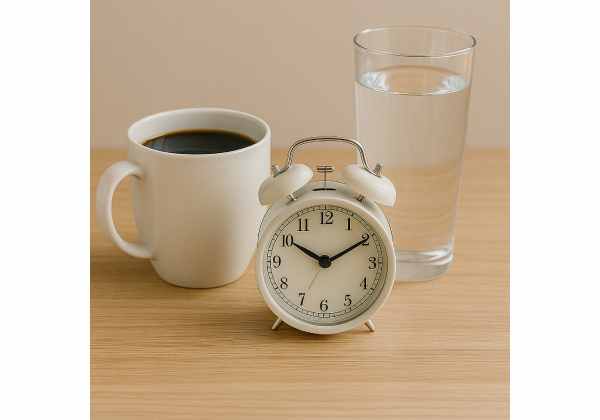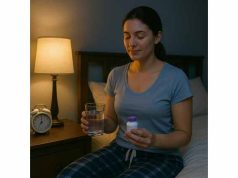
Coffee can help you feel alert, move more, and stick to your plan—if you time it well. Caffeine nudges energy and focus, but it also lingers for hours and can disturb sleep, which then raises cravings and weakens restraint. The goal is not more coffee. It is using the right dose at the right time, then stopping early enough to protect sleep. In this guide, you will learn how caffeine timing shapes appetite, movement, and recovery; how to set a daily schedule that fits your work and workouts; and how to avoid the common pitfalls that stall progress. If you are building broader skills—habits, sleep, and stress—start with our foundation on habit, sleep and stress essentials and plug the timing rules below into that routine.
Table of Contents
- Does caffeine timing help weight loss?
- Best time to drink coffee
- When to stop caffeine for sleep and appetite
- How much caffeine per day
- Common mistakes and fixes
- Who should be careful
- Evidence and sample schedules
- Frequently Asked Questions
Does caffeine timing help weight loss?
Caffeine does not melt fat. It influences the behaviors that drive fat loss: eating patterns, movement, and sleep. When you use it deliberately, you can curb afternoon sluggishness, increase the odds of doing your planned walk or workout, and avoid late-night cravings caused by poor sleep.
What caffeine does well
- Increases alertness and perceived energy for a few hours.
- Reduces perceived effort during activity, making movement feel easier.
- Can slightly blunt appetite in the short term, helping you delay snacking until a planned meal.
Where timing matters
- Caffeine’s half-life averages 4–6 hours, but the “tail” can last 8–10 hours in many people. A 3 p.m. coffee often echoes into bedtime.
- Drinking caffeine too soon after waking may feel great, but some people crash midmorning. A short delay lets natural morning alertness peak before adding a boost.
- A well-timed dose before movement (walks, strength, cycling) can make activity feel more doable—an important lever for sustainable weight loss.
Your success loop
Well-timed coffee → higher-quality movement → better mood and appetite control → easier adherence to meals → steadier weekly calorie deficit. Poorly timed coffee → lighter sleep → stronger cravings → skipped workouts → slower progress.
Baseline rules
- Use 1–3 cups of regular coffee (or equivalent) spread earlier in the day.
- Add one focused dose before planned movement if you tolerate it.
- Set a personal cutoff 8–10 hours before lights out.
- Do not drink caffeine to “fix” chronic sleep debt—fix the sleep.
If you want broader guardrails on safe rates of progress and plate-building that pairs well with caffeine timing, skim our quick overview of safe weight loss basics.
Best time to drink coffee
There is no single perfect time for everyone. Your ideal window depends on wake time, work demands, workout timing, and caffeine sensitivity. Use the frameworks below to build a schedule you can follow on busy days.
The morning window (60–120 minutes after waking)
Delaying your first caffeinated drink by about an hour lets your body’s natural alerting signals rise on their own. Many people avoid the midmorning “crash” by starting coffee after a glass of water and a brief light exposure (daylight or bright indoor light). If you wake at 06:30, test your first cup between 07:30 and 08:30.
Anchor coffee to a protein-first breakfast
Pair your first cup with protein and fiber (eggs and fruit, Greek yogurt with berries, tofu scramble). Caffeine alone can suppress appetite, leading to skipped meals and rebound snacking. Protein steadies energy and keeps you on plan.
Pre-workout timing (if you choose to use it)
- A modest dose about 30–45 minutes before your walk or workout often feels best.
- Effective ranges vary; many feel benefits with 1–2 mg/kg (roughly 70–140 mg for a 70-kg person). Start low.
- If you train early, your first cup can double as your pre-workout. If you train after work, use a smaller dose earlier in the afternoon and keep your cutoff intact.
Workday rhythm
- Cup 1: 60–120 minutes after waking.
- Cup 2 (optional): Late morning, not later than early afternoon.
- Cup 3 (if needed and you sleep well): Early afternoon, small dose, then stop.
On low-energy days
Try hydration, a 10-minute walk, and daylight exposure before pouring another cup. Often, movement and light deliver the alertness you wanted without compromising sleep.
Morning routine synergy
Caffeine timing works better when mornings are predictable. For a simple structure that helps you wake on time, get light, and move, see practical steps in our morning routine guide.
When to stop caffeine for sleep and appetite
Sleep quality drives appetite control and willpower. Protecting sleep is the single biggest reason to set a caffeine cutoff.
General rule
- Set your last caffeinated drink 8–10 hours before lights out. If you aim to sleep at 23:00, your cutoff is 13:00–15:00.
- Sensitive sleepers may need 10–12 hours. Track how you fall asleep and how you feel at wake; adjust by an hour each week.
Why the cutoff matters
- Even if you fall asleep, residual caffeine can reduce deep sleep and increase awakenings. That shows up the next day as stronger cravings and lower restraint.
- Caffeine later in the day often backfires: you feel wired at bedtime, then chase energy with more caffeine the next morning.
What to do instead of a late coffee
- Hydrate and take a 10-minute brisk walk to restore alertness without risking sleep.
- Use a power nap of 10–20 minutes before midafternoon if you sleep well at night. Avoid long naps that steal sleep pressure from the evening.
- Switch to decaf or herbal tea after your cutoff to keep the ritual.
Screen and light hygiene helps too
Reduce stimulating screens and bright overheads in the last hour before bed. Warm, dim light and calm content make it easier to feel sleepy at your target time. For sleep-protective light strategies, see tools in how much sleep you need.
If evenings are your only workout time
- Keep your last caffeinated dose small and earlier in the afternoon.
- Favor a longer cooldown, a warm shower, and a screens-off boundary to help sleep onset.
- If sleep still suffers, skip caffeine before evening sessions.
How much caffeine per day
Find the least caffeine that gives you the most benefit. More is not better; it is just more likely to disturb sleep and raise anxiety.
Practical daily ranges
- Many adults do well with 100–300 mg per day spread earlier in the day.
- An upper bound for most healthy adults is up to ~400 mg daily from all sources, but individual tolerance varies.
- For smaller bodies or higher sensitivity, aim for 100–200 mg.
Common sources (approximate)
- Brewed coffee (240 ml / 8 oz): 80–120 mg
- Espresso (30 ml / 1 oz): 60–75 mg
- Tea, black (240 ml): 40–70 mg
- Tea, green (240 ml): 25–45 mg
- Energy drink (250 ml): 80–160 mg (check label)
- Dark chocolate (40 g): 20–40 mg
Pre-workout dose
- Many people feel benefits with 1–2 mg/kg 30–45 minutes before activity (e.g., 70–140 mg for a 70-kg person).
- If you prefer not to count milligrams, a small coffee or one shot of espresso usually suffices.
Tolerance and cycling
- Daily high doses build tolerance. If caffeine stops helping, do not keep increasing.
- Try a lower daily total or take a 1–2 week deload (decaf only), then reintroduce smaller doses.
Add-ins count
- A latte with whole milk and syrups can add 150–300+ calories. Keep coffee a caffeine tool, not a dessert.
- Use milk or a small amount of your preferred sweetener, or switch one drink to americano or long black.
Hydration and food pairing
- Caffeine is mild diuretic at high doses, but typical intakes count toward fluids.
- Pair coffee with protein and fiber to steady appetite and avoid rebound snacking.
Common mistakes and fixes
Drinking coffee immediately on waking
You feel great, then crash by 10:30.
- Fix: Delay the first cup 60–120 minutes. Get daylight and water first. Pair coffee with a protein breakfast.
Afternoon “rescue” coffee
A 3:30 p.m. double shot props you up but costs you sleep.
- Fix: Set a cutoff 8–10 hours before bed. Use a 10-minute brisk walk, water, or decaf instead.
Using caffeine to mask poor sleep
More coffee cannot fix sleep debt.
- Fix: Protect your bedtime routine and light environment in the last hour of the day. If you need a simple night plan, see our practical steps in evening light strategies.
“Pre-workout” doses that are too big
Huge scoops cause jitters and stomach upset.
- Fix: Start with 1 mg/kg (or a small coffee) 30–45 minutes pre-session. Only increase if needed and if sleep remains good.
Hidden calories in coffee drinks
Your “energy boost” is a milkshake in disguise.
- Fix: Keep sweeteners small. Prefer americano, filter coffee, or espresso with milk used as a flavor, not the base.
Caffeine and cravings
Skipping food because coffee blunted hunger leads to evening overeating.
- Fix: Anchor your day with two protein-rich meals and plan one fiber-focused snack. Use caffeine to support, not replace, meals.
Weekend whiplash
Late coffees push bedtime later, Monday feels rough, and cravings surge.
- Fix: Keep wake time within an hour of weekdays. Maintain your cutoff even on weekends.
Who should be careful
Caffeine is generally safe for healthy adults in moderate amounts, but some situations call for caution or personalized advice.
- Pregnancy or trying to conceive: Keep daily caffeine low; discuss safe limits with your clinician.
- Insomnia or fragmented sleep: Tighten your cutoff (10–12 hours), reduce the total dose, or trial decaf weeks.
- Anxiety or panic symptoms: Smaller, earlier doses—or none—may be better. Watch for jitteriness and rumination.
- Gastroesophageal reflux (GERD): Coffee can worsen symptoms; test smaller doses, choose low-acid options, and avoid coffee close to meals.
- Hypertension or cardiac concerns: Monitor response; combine caffeine changes with medical guidance.
- Diabetes or reactive hypoglycemia: Pair caffeine with protein; be cautious about sweetened coffee drinks.
- Medications and supplements: Some interact with caffeine (stimulants, certain antibiotics, some antidepressants). Confirm with your clinician or pharmacist.
- Adolescents: Higher sensitivity; prioritize sleep and keep caffeine minimal.
Rule of thumb: if caffeine worsens sleep, mood, or symptoms, scale back or pause. Protecting sleep is more valuable for weight loss than any short-term boost.
Evidence and sample schedules
What the evidence suggests (big picture)
- Caffeine can lower perceived effort and improve performance in many people, which helps you move more and stick to training.
- It can reduce short-term appetite, but effects vary and often fade with tolerance.
- The most consistent pathway to better weight outcomes is sleep protection: well-timed caffeine supports sleep; poorly timed caffeine undermines it, raising cravings and reducing restraint the next day.
- Individual sensitivity varies widely due to genetics, dose, and timing. That is why personal testing over two to three weeks is essential.
Sample day schedules
Early riser, office schedule (wake 06:00, sleep 22:30)
- 06:05 Water and 5 minutes daylight.
- 07:15 First coffee with protein breakfast.
- 11:00 Optional small coffee or tea.
- Cutoff: 14:30.
- 17:30 10-minute walk before dinner.
- 21:30 Screens down; lights dim.
Lunch-hour lifter (wake 07:00, gym 12:30, sleep 23:00)
- 07:15 First coffee with breakfast.
- 12:00 Small pre-workout coffee (≈80–120 mg).
- Cutoff: 15:00.
- 18:30 Protein-rich dinner; evening decaf permitted.
After-work walker (wake 07:00, walk 18:00, sleep 23:00)
- 08:00 First coffee with breakfast.
- 11:30 Optional tea.
- Cutoff: 14:30.
- 18:00 30-minute brisk walk (no late caffeine).
- 22:00 Lights down.
Evening-team parent (wake 06:30, kids’ activities 19:00, sleep 23:00)
- 07:30 First coffee with breakfast.
- 12:00 Optional small coffee only if cutoff allows.
- Cutoff: 14:30.
- 19:00 Events—hydrate, then a short walk or stretch at home.
- 22:00 Warm shower, reading, lights out.
Traveler or jet-lag week
- Use caffeine strategically to match the destination daylight window: first dose after local morning light; strict cutoff aligned with the planned local bedtime. Keep total dose modest.
How to personalize
- Pick a cutoff based on bedtime (start with 8–10 hours).
- Choose one pre-movement dose if helpful.
- Keep total intake in a 100–300 mg range most days.
- Track sleep quality, appetite, and workout feel for two weeks; then adjust dose or timing by one small step at a time.
Expect results to be behavioral: steadier workouts, fewer evening snacks, smoother mornings. That is the quiet path most people need for sustainable fat loss.
Frequently Asked Questions
What is the best time to drink coffee for weight loss?
Many people do best with the first cup 60–120 minutes after waking and another late morning if needed. Pair coffee with a protein-rich breakfast to steady energy. If you train midday, a small pre-workout coffee 30–45 minutes before exercise can help.
How late is too late for caffeine?
As a rule, set your last caffeinated drink 8–10 hours before lights out. Sensitive sleepers may need a 10–12 hour buffer. If sleep is inconsistent, move your cutoff earlier by one hour and reassess after a week.
Does caffeine burn fat by itself?
Not meaningfully. Caffeine can make movement feel easier and reduce short-term appetite, but the major benefits are indirect: better workouts, steadier focus, and—when timed well—sleep that supports appetite control and decision making the next day.
How much caffeine should I use before a workout?
Start with 1 mg/kg (about 70 mg for a 70-kg person) 30–45 minutes before movement. If you tolerate it and sleep well, you can test up to 2 mg/kg. More is not better, and evening training may require no caffeine.
Is decaf useful for cravings?
Yes. Decaf preserves the ritual and warmth without disturbing sleep. Many people find a decaf or herbal tea after dinner satisfies the “something hot” urge that often leads to dessert or snacking.
Should I drink coffee before or after breakfast?
Either can work. If coffee suppresses appetite and causes you to skip breakfast, you may overeat later. Most people feel steadier when they pair coffee with protein and fiber (eggs, yogurt and fruit, tofu scramble).
References
- Scientific Opinion on the safety of caffeine 2015 (Guideline)
- Caffeine – StatPearls – NCBI Bookshelf 2024
- International society of sports nutrition position stand: caffeine and exercise performance 2021 (Guideline)
- Dose and timing effects of caffeine on subsequent sleep: a randomized clinical crossover trial 2024 (RCT)
- Caffeine Transiently Affects Food Intake at Breakfast 2018 (RCT)
Disclaimer
This article provides general education and is not medical advice. Caffeine affects people differently and can interact with medical conditions and medications. If you are pregnant, have anxiety, heart concerns, GERD, diabetes, insomnia, or take prescription drugs, discuss caffeine limits and timing with your clinician.
Share and Follow
If this guide helped, consider sharing it with a friend who wants steady energy without sacrificing sleep. For practical routines you can use right away, follow us on Facebook, X, or the social platform you prefer.










